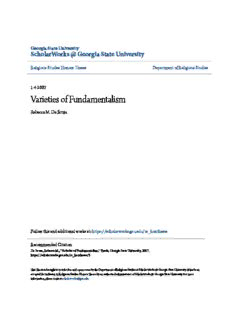
Varieties of Fundamentalism PDF
Preview Varieties of Fundamentalism
GGeeoorrggiiaa SSttaattee UUnniivveerrssiittyy SScchhoollaarrWWoorrkkss @@ GGeeoorrggiiaa SSttaattee UUnniivveerrssiittyy Religious Studies Honors Theses Department of Religious Studies 1-4-2007 VVaarriieettiieess ooff FFuunnddaammeennttaalliissmm Rebecca M. De Sousa Follow this and additional works at: https://scholarworks.gsu.edu/rs_hontheses RReeccoommmmeennddeedd CCiittaattiioonn De Sousa, Rebecca M., "Varieties of Fundamentalism." Thesis, Georgia State University, 2007. doi: https://doi.org/10.57709/1062088 This Thesis is brought to you for free and open access by the Department of Religious Studies at ScholarWorks @ Georgia State University. It has been accepted for inclusion in Religious Studies Honors Theses by an authorized administrator of ScholarWorks @ Georgia State University. For more information, please contact [email protected]. VARIETIES OF FUNDAMENTALISM by REBECCA M. DE SOUSA Under the Direction of Timothy M. Renick ABSTRACT The term “Fundamentalism” used as a comparative category within the academic study of religion has become problematic. Fundamentalism, is not one comprehensive movement but is, in fact, a phenomenon which encompasses a variety of beliefs, practices, and expectations. This thesis will explore the diversity of several different and distinct fundamentalist movements. I will discuss the natures of four Christian movements that have been labeled “fundamentalist” – Jehovah’s Witnesses, Christian Reconstructionists, Jerry Falwell and Pat Robertson – on several key points, eschatology, political philosophy, as well as level of social involvement. I will then turn to fundamentalism as it is used as a category to describe a global phenomenon. I will discuss three different scholarly approaches by turning to the work of Bruce Lawrence, Mark Juergensmeyer, and Bruce Lincoln on the Islamic “fundamentalist” group al- Qaeda. Finally I will argue that the category “fundamentalism” can be best understood in terms of a family resemblance. INDEX WORDS: Fundamentalism, Religion, Jehovah’s Witnesses, Christian Reconstructionists, Jerry Falwell, Pat Robertson, Osama Bin Laden, al-Qaeda, Family resemblance VARIETIES OF FUNDAMENTALISM by REBECCA M. DE SOUSA An Honors Thesis Submitted in Partial Fulfillment of the Requirements for Graduation with Undergraduate Research Honors in the College of Arts and Sciences Georgia State University 2006 VARIETIES OF FUNDAMENTALISM by REBECCA M. DE SOUSA Honors Thesis Director: Timothy M. Renick Honors Program Director: Robert Sattelmeyer Electronic Version Approved: Honors Program College of Arts and Sciences Georgia State University December 2005 Copyright by Rebecca Margaret De Sousa 2006 iv ACKNOWLEDGEMENTS I would like to thank the Religious Studies Department. It has been a rewarding experience to learn from and work with such a challenging faculty. I would like to express my gratitude to Kenny Smith and Dr. Timothy Renick. I am grateful for the encouragement, and guidance of Kenny Smith, for his prompting made this project possible. Likewise, I am grateful for Dr. Renick’s direction, and for agreeing to work with me on this project during his own research semester. Of course I would like to thank my family for their love and encouragement; Nathan for his uplifting cheer and support; and my boss, Mr. Carragher, for his patience and flexibility. Lastly, I would like to thank Pat Robertson and the 700 Club for providing hours of television enjoyment and inspiration. v TABLE OF CONTENTS ACKNOWLEDGEMENTS ……………………………………………………… v LIST OF TABLES ……………………………………………………………….. vii CHAPTER 1 Introduction …………………………………………………………… 1 2 Jehovah’s Witnesses …………………………………………………... 7 3 Christian Reconstructionists …………………………………………... 29 4 Jerry Falwell and Pat Robertson ……………………………………… 40 4.1 Jerry Falwell ...……………………………………………………. 40 4.2 Pat Robertson …………………………………………………….. 51 5 Comparisons of Four Christian Fundamentalist Movements .………… 64 6 Global Fundamentalism ..……………………………………………... 73 6.1 Osama bin Laden and the Rise of al-Qaeda ....…………………… 73 6.2 The Question of Global Fundamentalism ………………………... 82 7 Conclusion ...…..………………………………………………………. 96 WORKS CITED …………….……………………………………………………. 103 vi LIST OF TABLES Table 1. Family Traits of Fundamentalism Present in Five Fundamentalist Movements ……………………………………………………………… 98 1 1. Introduction The term “Fundamentalism” used as a comparative category within the academic study of religion has become problematic. In trying to understand fundamentalism, the term has been defined, redefined, repositioned, and discarded only to be applied once again. The history of the term fundamentalism begins in the early twentieth century in America. The Fundamentals, a publication widely circulated between 1910-1915, written by a panel of conservative Protestant evangelicals at Princeton, ushered in the fundamentalist movement. The contributors to The Fundamentals, including James M. Gray, James Orr, and Benjamin B. Warfield, “viewed themselves as affirming genuine historical and biblical Christianity.”1 They wrote in reaction to and against the popular liberal theology of the time and against Darwinism. In their defense of the true “historical and biblical Christianity” they formulated a list of five basic truths of Christianity they labeled the fundamentals. These five fundamentals are: i) the infallibility of Scripture, meaning that the Bible is the inerrant word of God: “God- breathed and thus possessing the quality of being free from error in all of its statements and affirmations;”2 ii) the Deity of Christ, including the Virgin birth of Christ, meaning that Christ Himself is God, He claimed Himself to be God, He was looked upon as being God,3 and He was conceived without sin; iii) the substitutionary atonement of 1 Ed Dobson, Jerry Falwell, and Edward E. Hindson, The Fundamentalist Phenomenon : The Resurgence of Conservative Christianity, 1st ed. (Garden City, N.Y.: Doubleday, 1981), 4. 2 Ibid., 8. 3 Ibid., 9.
Description: